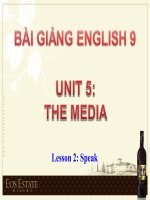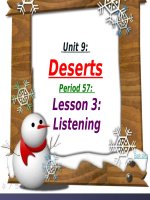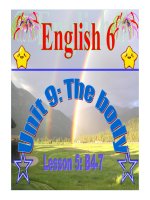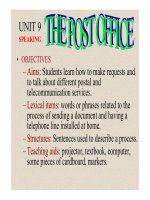Bài giảng Tiếng Anh 9 unit 9 (Read)
Bạn đang xem bản rút gọn của tài liệu. Xem và tải ngay bản đầy đủ của tài liệu tại đây (1.62 MB, 24 trang )
Look at the pictures of the natural disasters.
Then go to the board to write the words as quikly
as you can. You have only 30 seconds, when the time
is over you must stop.You will be the winners
if you have more words.
Time
OVER
earthquake
volcano
drought
flood
typhoon
snowstorm
Unit 9: Natural Disasters
Lesson 3 : Read
I/New words:
- collapse(v):
- tidal wave (n):
- abrupt (adj): (sudden)
- shift (n): (change or movement)
- erupt (v) / eruption (n):
- tornado (n):
- funnel-shaped (adj):
- (to)suck up:
Unit 9 : Natural Disasters
I/New words:
A
1.funnel shaped
2. tidal wave
3. tornado
4. shift
5. erupt / eruption
6. collapse
7. abrubt
8.suck up
Lesson 3 : Read
Matching
B
a . phun trào
b. sự chuyển dịch
c. sụp đổ
d. đột ngột
e. lốc xốy
f. hút lên
g. sóng thần
h. hình phễu
Unit 9 : Natural Disasters
I/New words:
A
1.funnel shaped
2. tidal wave
3. tornado
4. shift
5. erupt / eruption
6. collapse
7. abrubt
8.suck up
Lesson 3 : Read
Matching
B
a . phun trào
b. sự chuyển dịch
c. sụp đổ
d. đột ngột
e. lốc xốy
f. hút lên
g. sóng thần
h. hình phễu
Unit 9 : Natural Disasters
Lesson 3 : Read
I/New words:
- collapse(v):
- tidal wave (n):
- abrupt (adj):
- shift (n):
- erupt (v) / eruption (n):
- tornado (n):
- funnel-shaped (adj):
- (to)suck up:
*Questions
II/ Read:
Where is Kobe?
What happened in Kobe in 1995?
Do you know Mount Pinatubo?
Unit 9 : Natural Disasters
Lesson 3 : Read
Earthquakes:
of earthquakes
occur
Volcanoes:
We
cana Ninety
usually
predict
when
a volcano
erupt.
Typhoons:
Tidalwaves:
Tornadoes:
When
Tornadoes
tidalwaves
tropical
are
arepercent
funnel-shaped
storm
the result
reaches
ofwill
an
storms
120
arubt
kilometers
which
shift
inpass
the
per
I/New words: around
the
isEarth.In
known
as
the
of
Mount
Pinatubo,
which
ainvocalno
insuck
the
Philipines,
hours,
underwater
overland
it isPacific
below
called
movement
aRim,which
athunderstorm.
hurrican
ofisthe
North
Theyand
the
South
1960s,
up‘Ring
anything
America,
a huge
erupted
Itpath.
was
theItaly
world’s
largest
volcanic
eruption
Fire’.
In 1995,
huge
earthquake
city lifted
of
Kobe
tidalwave
athat
cyclone
isinin1991.
hit
their
inaAnchorage,
the
Australia,
In
Alaska.
a typhoon
in struck
1981,
The tidalwave
in
athe
tonado
Asia.The
traveled
word
a
II/ Read:
in who
morewas
thanasleep
50
years.
Hundreds
of
people
but
in
Japan.A
large
number
ofbaby
people
were
killed
when
baby,
“typhoon”
comes
from
from
Alaska
inChines:
its
to
California!
tai
carriage,
means
“big”
intodied,
the
and
airfeng
and
thousands
were
saved
because
scientists
had
warned
them
homes,
office
blocks
and“typhoon”
highways
collapsed
means
“wind”,
put
itso
down
the word
safely
100
meters
means
away.
“big
wind”
Predict
True or Falseabout the eruption.
1. Most of the earthquakes in the world occur in the
Ring of Fire.
2. The earthquake in Kobe in 1995 caused severe
damage.
3. A huge tidal wave traveled from California to Alaska
and hit Anchorage in the 1960s.
4. Typhoon, hurricane and tropical storm are different
words for the same natural disaster.
5. The eruption of Mount Pinatubo is the world’s largest
ever volcanic eruption .
6. A tornado looks like a funnel .
Read
T
F
T
F
Unit 9 : Natural Disasters
Lesson 3 : Read
I/New words:
II/ Read:
1.True or False
2.Complete the sentences
10
50
20
30
40
60
70
80
Lucky Numbers
The rules: I have 8 boxes with the points on (from 10 to 80), 6
ones for 6 sentences and 2 for “lucky numbers”. You choose each
one and do your task (complete the sentence). If you are right, you
get the points, if not, the other team will take your chance and get
half the points. For the lucky one you get the points and don’t have
to do any task, but the turn will be the other team’s.
Unit 9 : Natural Disasters
Lesson 3 : Read
I/New words:
II/ Read:
1.True or False
2.Complete the setences
Lucky Numbers
10
50
20
30
40
60
70
80
L u ck y N u mb er s
1. The majority of
occur around the Pacific Rim?.
earthquakes..………………………………..
people were
killed wheninhomes,office
2.During
the earthquake
Kobe, many
blocks and highways collapsed .
……………………………………………
…………………………………
3.A tidal wave can only occur
there is an abrupt shift in the
when…………………………….
underwater
movement
of
the
Earth
.
…………………………………
4.In Australia,
a tropical
a cyclone
. storm is
known as……………
5.The
language“gave
the Chinese
word “ typhoon
us………………...........
Unit 9: Natural Disasters
Lesson 3: Read
I/New words:
II/ Read:
1.True or False
2.Complete the sentences
1.
The majority of earthquakes occur around the Pacific Rim, known as
a Ring of Fire.
2. During the earthquake in Kobe, many houses, office buildings and
highways collapsed .
3. A tidal wave can only occur when there is an abrupt shift in the
underwater movement of the Earth.
4. In Australia, a tropical storm is known as a cyclone
5. The Chinese language gave us the word “typhoon”.
6. A tornado is a type of storm that has a funnel shape and suck up
anything in its way
Unit 9: Natural Disasters
Lesson 3: Read
I/New words:
II/ Read:
1.True or False
2.Complet the sentences
Discussion
a.Where do most of earthquakes happen?
b.What does “typhoon” mean?
c.Can we predict when a volcano will erupt?
d.What natural disasters often occur in Vietnam?
e.When do tidal waves happen?
f.What does a tornado look like?
g.When do typhoons often occur in VietNam?
h.What can we do when natural disaters cause a lot of damages
to others people?
Unit 9: Natural Disasters
Lesson 3: Read
I/New words:
II/ Read:
1.True or False
2.Complet the sentences
Discussion
a.Where do most of earthquakes happen?
- They happen around the Pacific Rim
b.When do tidal waves happen?
- Tidalwaves happen when there is an arupt shift in the
underwater movement of the Earth.
c.Can we predict when a volcano will erupt?
- Yes, we can. The scientists can warn us about the eruption.
d.What natural disasters often occur in Vietnam?
- Floods, typhoons and tornadoes often occur in Vietnam.
Unit 9: Natural Disasters
Lesson 3: Read
I/New words:
II/ Read:
1.True or False
2.Complet the sentences
Discussion
e.What does “typhoon” mean?
- It means “big wind”.
f.When do typhoons often occur in VietNam?
- Typhoons often occur in July and August.
g.What does a tornado look like?
- It looks like a funnel
h.What can we do when natural disaters cause a lot of
damages to other people?
- We can raise money for the people, clothes and books for
the children in the disaster areas.
Unit 9: Natural Disasters
Lesson 3: Read
I/New words:
- collapse(v):
- tidal wave (n):
- abrupt (adj):
- shift (n):
- erupt (v) / eruption (n):
- tornado (n):
- funnel-shaped (adj):
- (to)suck up:
II/ Read:
1.True or False
2.Complet the sentences
Learn
the new words by heart.
Write
the complete sentences.
Do ex 7 / P.64 (workbook).
Prepare
for: Write / P.79, 80.









